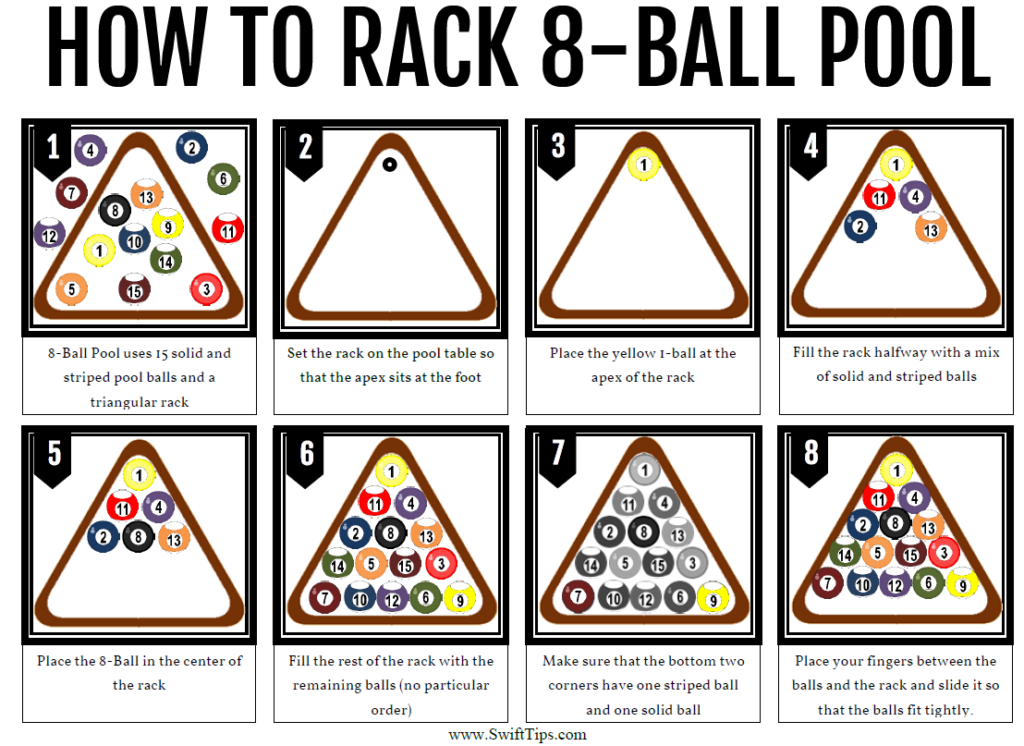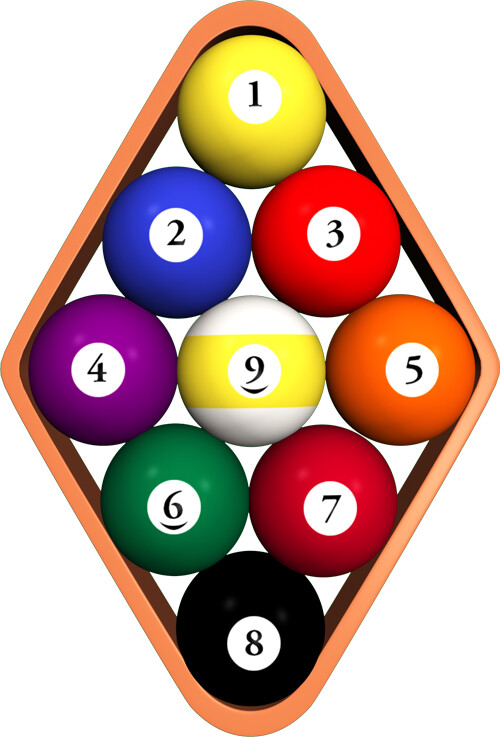Mastering Pool Racking: Your Complete Guide & Tutorial
Is there a secret to consistently perfect pool racks that can elevate your game and frustrate your opponents? Mastering the art of racking pool balls is not just a pre-game ritual; it's a foundational skill that can significantly influence the outcome of every match.
Racking pool balls might seem like a simple, even trivial, task, but its impact on the quality and fairness of the game is undeniable. Correct racking adheres to specific standards, which ensures a balanced and engaging experience for all players. Failing to rack properly can lead to an uneven distribution of balls, potentially creating unfair advantages or disadvantages. This article delves into the intricacies of racking, offering a comprehensive guide to mastering this essential aspect of the game. We will unravel the complexities of the pool tables anatomy and explore various racking methods.
Before diving into the specifics, it is essential to understand the key components that contribute to a successful rack. First, youll need a standard set of billiard or pool balls (16 balls) and a triangular rack, which is the primary tool for organizing the balls. This article, complete with illustrations, images of different racks, and even a video tutorial, ensures you master the art of racking in no time.
Let's examine some different pool variations and how racking works.
Here's a table detailing the key aspects of racking in various pool games:
| Game Type | Rack Shape | Apex Ball | 8-Ball Placement | Corner Ball Requirements | Ball Order |
|---|---|---|---|---|---|
| 8-Ball | Triangle | Not specific | Center of the triangle | One solid, one stripe | Random, except for the 8-ball and corner balls |
| 9-Ball | Diamond | 1-ball | Not applicable | Not applicable | 1-ball at the apex, 9-ball in the center, others random |
| 10-Ball | Triangle | 1-ball | Not applicable | One solid, one stripe | 1-ball at the apex, 10-ball in the center, others random |
| Straight Pool (14.1 Continuous) | Triangle | Not specific | Not applicable | Not applicable | Random, but balls must be racked tightly |
For more information, please visit: Colorado State University Billiards.
The foundation of a good game begins before the break. Racking pool balls correctly is the first step. The objective is to establish a fair and balanced starting position for the game. This ensures that each player has an equal chance of initiating a successful break and establishing control of the table.
The most common method uses a standard set of 16 billiard balls and a triangular rack. The rack is positioned on the foot spot, a marked location typically indicated by a small dot on the table. This spot serves as the central point for the arrangement.
The process of racking is as follows:
- Place the triangle rack on the pool table over the foot spot.
- Arrange all fifteen balls randomly within the rack.
- Place any stripe and any solid ball in the bottom corners.
- Position the rack so that the one ball sits on top of the foot spot (for games that specify this).
- Ensure that the apex (front) of the triangle is facing the foot end of the table.
The goal is to have the balls tightly packed within the rack. This is achieved by ensuring the balls are in direct contact with each other. This tight formation is essential for transferring energy from the cue ball upon the break.
The breaking player has the option to request and receive a rerack if the initial break does not result in a satisfactory spread of the balls. The rerack ensures that the game begins with a fair arrangement of balls. The player who loses the lag, or loses any subsequent game, is responsible for racking for their opponent. This rule promotes a balanced approach to the game.
Each pool game has its own distinct ball order and racking methods. Eight-ball, one of the most familiar pool games, requires specific ball placement. Nine-ball and ten-ball variations have different requirements, and racking techniques.
In general, the key to a successful rack lies in moving the balls efficiently and positioning them precisely within the corners of the triangle. A proper rack only requires a solid and stripe at the bottom two corners, the rest of the balls should be randomly placed in the rack, with the 8-ball in the middle. These tools play a vital role in achieving a tight and uniform rack.
For Eight-ball:
In this popular variation, a standard rack is used, with the apex ball not specifically designated. The eight-ball must be in the center of the triangle. The corners of the triangle must consist of one solid and one striped ball. The remaining balls can be arranged randomly. Racking in the correct manner for eight-ball is one of the most important aspects for a good game, if the balls are not racked correctly it can affect the break, and the quality of game.
The correct way to set them up in the majority of leagues, tournaments and professional events throughout England, Ireland, Scotland, and Wales is this: Place the triangle rack on the pool tables foot spot. Place all 15 object balls (stripes and solids) in the rack in a random order, ensuring that the corners are filled with one solid and one stripe ball.
For Nine-ball:
Nine-ball uses a diamond rack instead of a triangle. The one-ball is placed at the apex of the diamond. The nine-ball is placed in the center of the diamond. The other balls are placed randomly around the one and nine balls.
For Ten-ball:
The rules for ten-ball are similar to those of eight-ball, the same triangle rack is used, with the one-ball placed on the foot spot. The 10-ball is placed in the center of the rack. The remaining balls are arranged randomly. The corner balls must include one solid and one stripe.
The methods for racking vary with each game. As a beginner, you need to learn the basic skills and practice them. Understanding the subtle differences between each rack and adhering to these guidelines will increase your chances of achieving a fair break and starting your games on the right foot.
For a good rack, the balls need to be packed tightly together to maximize the force transferred from the cue ball during the break. This often involves using a fresh set of balls that are free of debris. Start by ensuring that your pool balls are clean and free of debris. Once you have set the rack, align the balls and rack with the center mark, then press the balls forward and remove the rack by the corner holes or the ergonomic grip. There are some considerations for achieving the perfect rack every time. The most important points are:
- Clean Balls: Always start with clean balls, free from dirt and grime.
- Rack Condition: Use a rack in good condition; a warped or damaged rack will affect the outcome.
- Table Surface: The table surface must be level.
- Tight Packing: Ensure the balls are touching each other tightly.
- Apex Position: Correctly place the one-ball at the apex for games that require it.
- Corner Placement: Place a solid and a stripe in the corners for some game types.
- Eight Ball Placement: Place the eight-ball correctly in the center for eight-ball.
- Random Order: Ensure the remaining balls are randomized as per game rules.
- Foot Spot: Center the rack on the foot spot accurately.
These considerations, when followed consistently, will significantly improve your ability to rack balls for any pool game. This is an integral part of the game and contributes to a fair and competitive experience for all players. Whether you're playing a friendly game with friends or competing in a tournament, proper racking is essential.
Mastering the art of racking is a fundamental skill that will impact every game you play. By understanding the variations, adhering to the best practices, and paying close attention to detail, you will significantly improve your game. Remember that the goal is always to set the stage for a fair, exciting, and well-played match. Consistent effort and attention to detail will make you a better pool player.



Detail Author:
- Name : Elta Baumbach DVM
- Email : ariane.russel@baumbach.com
- Birthdate : 1995-12-31
- Address : 297 Tatyana Club North Vernice, SC 70118
- Phone : +1.260.344.1432
- Company : Koss, Barrows and Stark
- Job : Machinery Maintenance
- Bio : Id quis repudiandae nisi dolores quis. Dolorem dolorum odit ut repudiandae sed. Possimus nulla ipsa consequatur. Animi aliquid deleniti esse doloribus.